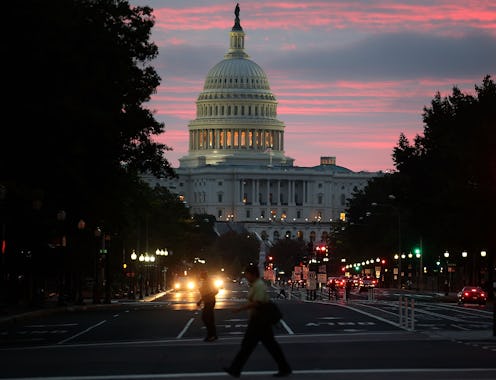News
Your Vote Could Be The Deciding Factor On Nov. 4
This year's race to Washington has been nastier, more expensive, and most importantly, closer than any recent midterm elections — polls show Republicans and Democrats in a dead heat as November 4 inches closer. At Saturday's Dartmouth College rally, Senator Jeanne Shaheen and Congresswoman Annie Kuster reiterated what we've heard countless times in anticipation of voting day — this race really matters more than most. At stake is Republican control of Congress, which Democrats fear will sound the death knell of all progress in Washington (because there's so much progress in Washington today). But with ever-increasing ideological differences between the parties, the 2014 midterms are indeed important, and even the best of forecasters are stumped by what will happen on Tuesday.
According to the last national NBC News/Wall Street Journal poll before the election to be released Sunday evening, 46 percent of likely voters would prefer to see a Republican Congress, and 45 percent say they'd rather see Democrats remain in power. This overall trend of indecisiveness reflects statewide races that remain too close to call in the days before election day. Many of the tightest races, like those in Georgia, North Carolina and Colorado are veritable tossups, with no clear indication of whether voters will swing left or right when the chips fall.
In order for the Republicans to regain control of Congress, they will need to pick up a total of six seats, which will give them a 1-person majority in the Senate. It is nearly impossible for them to lose their solid majority in the House of Representatives, and as such, these last few months have focused almost exclusively on Senate races in eight battleground states, only few of which are typically thought to be particularly contentious.
And interestingly enough, of the eight swing states in these 2014 midterms, four of them were equally crucial in the 2012 elections — Iowa, New Hampshire, Colorado and North Carolina figured heavily in the Obama-Romney race that determined whether a Democrat or Republican would sit in the White House, and once again, the pressure is on in these states to determine whether the blue keeps or cedes its control of the legislative branch of American government.
The latest NBC News/Journal poll shows a slightly closer race than the results from last month, during which the GOP claimed a 2-point lead over the Democrats with 46 percent of voters opting for the Republicans to take the Senate, and only 44 percent hoping that the Democrats would keep it. Compare these margins to the numbers before the 2010 midterms, in which the Republicans led Democrats by 6 points nationwide, and won handily and hugely. In fact, the 2010 midterms represented the largest political turnover in Congress since the Great Depression, with the Republicans recapturing 63 seats in the House, making it the biggest seat change in any midterm election in over 70 years.
But this year, no such landslides are to be expected. Rather, whatever victories are to be won will be hard fought and at slim margins — in Iowa and North Carolina, the two states that will likely serve as the final arbiters of 2014, leaders have only a two-point margin of victory over their opponents in polls that have a 4-point margin of error.
So what do Democrats need to stay in power? The blue party is undoubtedly playing defense to the GOP's strong offense this year, but the Dems have been slightly more successfully in fending off their attackers than anticipated. They'll need to keep five seats in order to maintain possession of the Senate, as this would place the Senate in a 50-50 split. In this case, Vice President Joe Biden — the president of the Senate — would break tied votes in favor of Democrats.
In New Hampshire and North Carolina, Democratic women currently hold the Senate seats up for grabs. Senator Jeanne Shaheen of New Hampshire is looking to defeat Scott Brown, who previously represented Massachusetts in the Senate from 2010 to 2013 before being unseated by Sen. Elizabeth Warren (D-MA). Brown seemed to be an unlikely candidate, as no individual since the early 19th century has managed to represent two different states in the United States Senate. But Brown has managed to overcome his carpetbagger status and give Shaheen a considerable run for her money (and her seat). While Brown would become the first person in well over 100 years to sit in Senate for two different constituencies, Shaheen hopes that he will make history in a very different way — becoming the first man to be defeated by two different women in midterm elections.
Kay Hagan, on the other hand, is another relative newcomer to the Senate, who road the coattails of President Obama's 2008 success in North Carolina all the way to Washington, DC. But now, plagued by her support of the president's unpopular policies, Hagan risks losing to Thom Tillis, North Carolina's Speaker of the House.
Democrats would also need the Republican candidates to lose in two typically red states — Kansas and Georgia. This may be possible, as Georgia looks to be headed for a runoff, and Kansas' results remain up in the air, with Independent candidate Greg Orman looking to edge out his competitor.
This would give Democrats four out of the necessary five, which would mean that Sen. Mark Udall of Colorado would need to somehow prove pollsters wrong and defeat Rep. Cory Gardner, or have Bruce Braley of Iowa overcome what is now a seven-point deficit to defeat Republican Joni Ernst.
Regardless of what happens, it will come down to the wire. November 4 will be a day of reckoning for politicians across the country, and with elections this close, every vote will count. Make sure yours is one of them.
Images: Getty Images (5)
